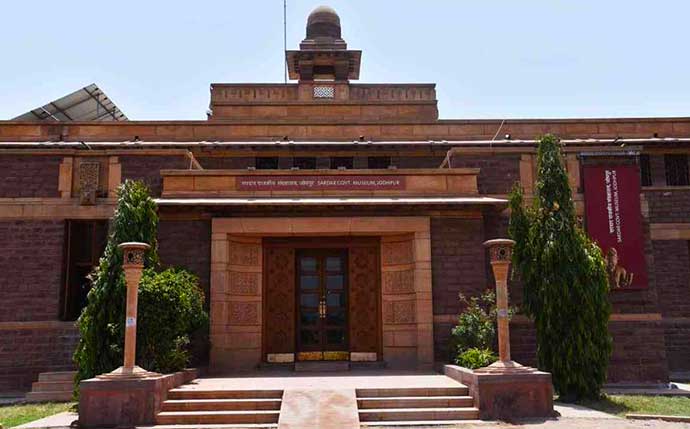Jodhpur, often referred to as the Blue City of Rajasthan, is home to numerous architectural marvels and historical treasures. Among them, the Sardar Government Museum, nestled in the heart of the vibrant city, is a must-visit destination for history enthusiasts, art lovers, and anyone curious about Rajasthan’s rich cultural heritage. This guide provides all the essential details you need for an unforgettable visit.
Location
The Sardar Government Museum is located in Umaid Public Garden, a sprawling green space in the heart of Jodhpur city. The museum’s serene surroundings make it a perfect spot to combine culture and leisure in one visit.
Address: Umaid Public Garden, High Court Road, Jodhpur, Rajasthan 342006
Opening Hours: 10:00 AM – 5:00 PM (Closed on Fridays and public holidays)
Entry Fee: ₹20 (Indian nationals) | ₹50 (foreigners)
How to Reach
By Air
The nearest airport is Jodhpur Airport, located just 4.5 km from the museum. From the airport, you can hire a taxi or auto-rickshaw to reach the museum in under 15 minutes.
By Train
Jodhpur Junction Railway Station is around 2.5 km from the museum. A quick auto-rickshaw or taxi ride will take you directly to Umaid Public Garden.
By Road
Jodhpur is well-connected by road to major cities in Rajasthan and beyond. Public and private buses frequently operate to Jodhpur. From the city center, the museum can be easily accessed by local transport, such as autos, e-rickshaws, or taxis.
History
The Sardar Government Museum, named after Maharaja Sardar Singh of Jodhpur, was established in 1909 and opened to the public in 1936. Designed by renowned architect Henry Vaughan Lanchester, the museum was created to preserve and showcase Rajasthan’s art, history, and culture. Its establishment reflects the vision of Maharaja Sardar Singh to document and celebrate the region’s heritage.
Over the decades, the museum has become a hub for historians and tourists who seek to delve into Jodhpur’s illustrious past.
Attractions
The museum’s exhibits are a rich blend of history, art, and culture. Here’s what you can expect:
1. Archaeological Artifacts
The museum houses an extensive collection of artifacts, including ancient inscriptions, sculptures, and relics from the early Gupta and Rajput periods. These provide a fascinating glimpse into the region’s ancient history and craftsmanship.
2. Weapons and Armor
A section of the museum is dedicated to Rajputana’s martial legacy, showcasing swords, shields, daggers, and other weapons. The intricate designs on these weapons highlight the artistic prowess of the time.
3. Miniature Paintings
The museum features a stunning collection of Rajasthani miniature paintings, each depicting scenes from royal life, mythology, and folklore. These delicate works are a testament to the vibrant artistic traditions of the region.
4. Textiles and Handicrafts
Visitors can marvel at traditional Rajasthani textiles, including bandhani (tie-dye) fabrics, embroidered garments, and antique carpets. These exhibits showcase the state’s rich textile heritage.
5. Natural History Section
For nature enthusiasts, the museum includes a section displaying stuffed wildlife specimens and fossils. This collection is particularly fascinating for those interested in Rajasthan’s ecological diversity.
6. Umaid Public Garden
The museum is surrounded by the lush Umaid Public Garden, which adds to the charm of the visit. The garden features fountains, walking paths, and benches, making it an ideal place to relax after exploring the museum.
Key Facts for First-Time Visitors
Cameras and Photography: Photography may be restricted in certain sections. Check with the staff before capturing photos.
Best Time to Visit: October to March is the ideal time to visit Jodhpur, as the weather is pleasant for sightseeing. Morning visits are recommended to avoid crowds.
Guides and Audio Tours: Local guides are available at the museum to provide in-depth information about the exhibits. Alternatively, audio guides can enhance your experience.
Travel Tips
Combine Your Visit: Plan your visit to include nearby attractions like Mehrangarh Fort, Jaswant Thada, and Umaid Bhawan Palace, all within a short distance from the museum.
Hydrate and Dress Comfortably: Rajasthan can be warm, so carry water and wear light, breathable clothing.
Check for Events: The museum occasionally hosts cultural exhibitions and workshops. Inquire at the ticket counter for upcoming events.
Souvenirs: Nearby markets, such as Sardar Market, are great for purchasing traditional handicrafts, jewelry, and textiles as souvenirs.
Why Visit the Sardar Government Museum?
For those eager to explore the art, history, and culture of Rajasthan, the Sardar Government Museum offers a comprehensive experience. Its diverse collection, coupled with the peaceful setting of Umaid Public Garden, makes it a standout attraction in Jodhpur. Whether you’re a history buff, an art lover, or simply a curious traveler, this museum promises an enriching journey through the heritage of the Blue City.

